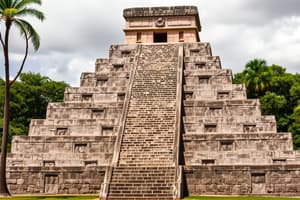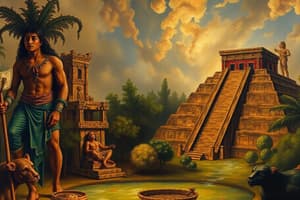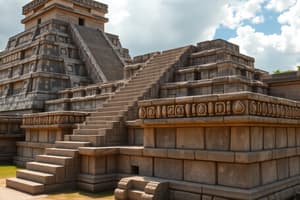Podcast
Questions and Answers
What was the most significant legacy of the Olmec civilization?
What was the most significant legacy of the Olmec civilization?
- Their stone carvings of gods
- Their tradition of priestly leadership and religious rituals (correct)
- Their agricultural developments
- Their pyramid-shaped temples
Which of the following calendars was used by the Maya to track longer periods of time?
Which of the following calendars was used by the Maya to track longer periods of time?
- Haab
- Sidereal
- Tzolkin
- Long count (correct)
What primary function did the Iroquois league serve among Native American tribes?
What primary function did the Iroquois league serve among Native American tribes?
- Military cooperation against other tribes
- Political representation in government
- A platform for peace between tribes (correct)
- Economic alliance for trade
How did the Inca maintain communication without a writing system?
How did the Inca maintain communication without a writing system?
What farming technique did the Maya utilize to manage floodwaters?
What farming technique did the Maya utilize to manage floodwaters?
Which feature is NOT characteristic of the shared traits of Maya, Aztec, and Olmec civilizations?
Which feature is NOT characteristic of the shared traits of Maya, Aztec, and Olmec civilizations?
Which aspect of the environment was crucial for the Aztec civilization?
Which aspect of the environment was crucial for the Aztec civilization?
What was a primary function of the geoglyphs created by the Nazca culture?
What was a primary function of the geoglyphs created by the Nazca culture?
What was unique about the housing structures of the Ancestral Puebloans?
What was unique about the housing structures of the Ancestral Puebloans?
What social role did the Sapa Inca fulfill in Incan society?
What social role did the Sapa Inca fulfill in Incan society?
Flashcards are hidden until you start studying
Study Notes
Olmec Civilization
- Influenced other civilizations through trade and cultural contributions such as art, calendar, writing system, and religion.
- Most important legacy is tradition of priestly leadership and religious rituals.
- Carved jade figurines of gods and giant stone heads, potentially portraying their rulers.
- Influence visible in Mesoamerican art.
Maya Civilization
- Known for towering stone temples, palaces, and monuments called stelae, featuring images of nobles, warriors, gods, and rulers.
- Developed a hieroglyphic writing system, astronomy, astrology, mathematics, and a counting system.
- Utilized three calendars: long count, tzolkin, and haab, serving different purposes.
- Each city-state had its own ruler, typically a male, and traded with each other, exchanging goods for daily use and social status symbols.
- Employed controlled fires for land clearing and raised platforms for flood-resistant crops.
Aztec Civilization
- Capital was Tenochtitlan, a wealthy city due to taxes collected through warfare.
- Located in the Valley of Mexico, characterized by high mountains, surrounding lakes, and a mild climate.
Shared Characteristics of Maya, Aztec, and Olmec Civilizations
- Pyramid-shaped temples.
- Ball courts linked to religious rituals.
- Polytheistic beliefs.
- Hierarchical social structures.
- Reliance on agriculture.
- Established armies.
Inca Civilization
- Quechua was their primary language, imposed on conquered people to promote cultural assimilation.
- Resided in a diverse environment featuring warm climates, coastal areas, deserts, high mountains, tropical forests, and jungles.
- Sapa Inca, the emperor, was considered a divine leader and absolute ruler, controlling politics, the army, and territorial expansion.
- Subjects were generally treated well, while nobles governed provinces and officials enforced laws and organized labor.
- Nazca culture created geoglyphs in the desert, including straight lines and giant animal figures, potentially holding spiritual significance.
- Moche farmers developed intricate irrigation systems and soil fertilization techniques for efficient agriculture.
- Utilized quipu, a system of knotted strings, for communication and record keeping, as they did not possess a written language.
Iroquois League
- Alliance formed by Native American tribes around the Great Lakes region.
- Established to promote peace and cooperation between tribes.
Inuit Adaptation
- Small bands survived through hunting and fishing, relying on sea mammals for various resources.
- Utilized kayaks and dog sleds for transportation.
- Constructed igloos and sod dwellings for shelter.
Native American Irrigation and Canals
- Hohokam people developed complex irrigation systems and canals in desert environments to carry river water to fields.
Ancestral Puebloan Structures
- Constructed housing complexes on cliffs along canyon walls, using mud as a building material suitable for arid environments.
- These structures offered protection from raiders.
- Built freestanding villages (pueblos) with multi-floor houses connected by doorways and ladders, capable of holding 3000 people across 5 stories.
- A small hole in the floor symbolized the birthplace of the tribe, and walls were often painted with geometric shapes, likely representing rituals or daily life.
Hohokam Civilization
- Cultivated corn, beans, and squash in the desert region of present-day Arizona.
- Lived near the Salt and Gila rivers, creating intricate irrigation systems.
- Built temple mounds and ball courts.
- Their descendants are the Pima and Papago people.
Mississippian Civilization
- Constructed mounds that housed rulers and nobles.
- Worshiped the sun and had powerful leaders.
- Grew corn and lived in small homesteads.
- Engaged in trade.
Common Theory Regarding People in the Americas
- A land bridge connecting Asia and North America existed during the Ice Age, allowing people to migrate across.
- Some individuals may have settled along the west coast using small boats.
Studying That Suits You
Use AI to generate personalized quizzes and flashcards to suit your learning preferences.




